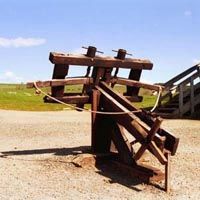Ballista (the Greek ballistra) was a kind of heavy crossbow, projecting missiles (arrows, stone balls, stones, beams with iron), with average weight from 30 to 100 kg, on flat track over a distance of 200 – 400 meters (shots up to over 1000 meters).
Ballista was used to destroy walls and fortifications as well as on the battlefield in order to decimate enemy units. It resembled the shape of a powerful crossbow on a wagon that usually drew oxen or mules (carroballista). The big crossbow was drawn by the guts of animals, which allowed her to throw missiles at very long distances. Winded with a special crank, it worked like a crossbow. Sometimes it was used to destroy city gates instead of a battering ram.
Eight people were needed to handle the ballista. The soldier serving the ballista was called ballistarius.
The ballista is considered the greatest achievement of the ancient war engineering. Precise math calculations made it possible to build a launcher of any size, and no other weapon was equal to its accuracy or destructive power in those times.
Vitruvius mentions the principles that should be followed when building a ballista:
[…] The constructions of balistæ are various and different, though contrived to produce similar effects. Some of these are worked by windlasses, others by systems of pulleys, others by capstans, and others by wheels: no balista, however, is made without regard to the weight of the stones it is intended to throw. Hence the rules will only be understood by those who are acquainted with arithmetical numbers and their powers.
For instance, holes are made in the capitals, and through them are brought the cords, made either of woman’s hair, or of gut, which are proportioned to the weight of the stone that the balista is to throw, as in the catapultæ the proportions are derived from the length of the arrow. But that those who are not masters of geometry and arithmetic, may be prepared against delay on the occasions of war, I shall here state the results of my own experience as well as what I have learnt from masters, and shall explain them, by reducing the Greek measures to their correspondent terms in our own.
– Vitruvius, De architectura, XI, 1-2
For comparison, let’s read the description provided by Ammianus Marcellinus:
Between two posts a long, strong iron bar is fastened, and projects like a great ruler; from its smooth, rounded surface, which in the middle is highly polished, a squared staff extends to a considerable distance, hollowed out along its length with a narrow groove, and bound there with a great number of twisted cords. To this two wooden rollers are very firmly attached, and near one of them stands the gunner who aims the shot. He carefully places in the groove of the projecting iron bar a wooden arrow, tipped with a great iron point. When this is done, strong young men on both sides quickly turn the rollers and the cords. When its point has reached the outermost ropes, the arrow, driven by the power within, flies from the ballista out of sight, sometimes emitting sparks because of the excessive heat. And if often happens that before the weapon is seen, the pain of a mortal wound makes itself felt.
– Ammianus Marcellinus, Res Gestae, XXIII, 4, 2








